You often know the spider due to its web-making capability, but the bold-jumping spider is a distinct creature that preys without webs. This tiny, furry spider jumping around your home or garden, scientifically known as Phidippus audax, is commonly found across North America.
You need to know their size, lifespan, housing needs, handling, and more to keep them as a pet. But don’t worry; with essential information like providing an enclosure with the substrate, foliage, climbing areas, feeding live insects, and gentle handling, you can keep a bold black spider as a fascinating pet.
But the question is how to properly care for, handle, and ensure the health of a Phidippus audax if you need to know all the details. Let’s discuss it in detail:
An Introduction to the Bold Jumping Spider
The bold jumping spider is a widespread jumping spider in North America. Its scientific name is Phidippus audax. They earned the name “bold” due to their curious and fearless nature, often jumping directly toward potential threats to investigate.
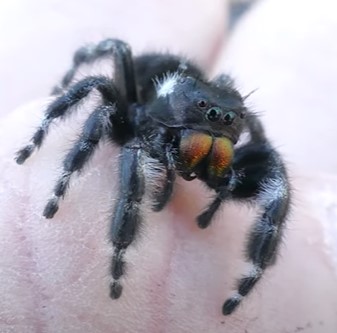
Some key facts about the bold pet:
- Appearance: The fuzzy and black spiders have bright white patches on the top and sides of the abdomen. The male Phidippus audax has noticeably larger pedipalps (small appendages near the mouth).
- Lifespan: 1-2 years in captivity.
- Native Habitat: Found throughout North America in gardens, forests, grasslands, and deserts. They construct silken tubes under rocks, bark, or foliage.
- Spider’s Diet: Insects like flies, moths, crickets, beetles, and other spiders.
Now that you know the basics, let’s move further to understand what makes the bold jumping spider such a fascinating creature!
Why the Black Bold Makes a Great Pet
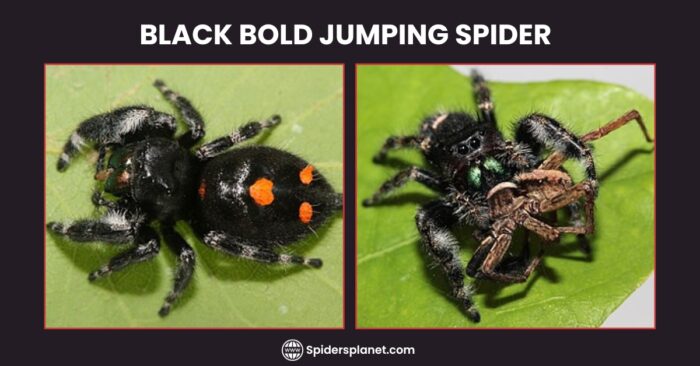
The bold jumping spider can make an excellent pet for the right owner. Some of the reasons why:
Interactive and intelligent:
Jumping spiders are incredibly alert and aware of their surroundings. They watch you intently and can even be hand-fed.
Minimal care:
They require a simple housing setup and only need to be fed insects 2-3 times per week. Relative to other exotic animals kept as pets, they require very minimal care and maintenance.
Cannot hurt you:
These spiders have no venom or fangs that can harm humans. At worst, a bite would be like a tiny pinprick.
Small size:
Their tiny size of 1/4 inch to 5/8 inch makes them easy to house. A small tank or terrarium is perfect.
Fun to watch:
With their inquisitive nature and ability to leap 8-10 times their body length, bold jumpers are highly entertaining.
Do not need to be handled:
If taking concerns you, bold spiders are content without it. You can enjoy watching them in their habitat.
The bold jumper has a 1-2 years longevity in captivity if cared for properly. Their small size, low care needs, harmless venom, and engaging personalities make them ideal arachnid pets.
Where do bold-jumping spiders live?
They are found worldwide in many diverse habitats. They often live in vegetation like forests, jungles, gardens, and grasslands. The bold jumping spider hunts in a unique way. It does not make webs like some other spiders.
Instead, it jumps onto its prey to catch it. This is why it is called a jumping spider. These spiders jump forward to grab bugs to eat. They are found all over North America jumping on their prey. The bold creature can adapt to various temperatures and is located on every continent except Antarctica.
Is the Bold Jumping Spider Poisonous or Dangerous?
Some may be wary of getting a bold spider due to venom and human danger concerns. However, rest assured that the brave creature is not poisonous or a threat to people.
Let’s discuss some bold jumping spider facts:
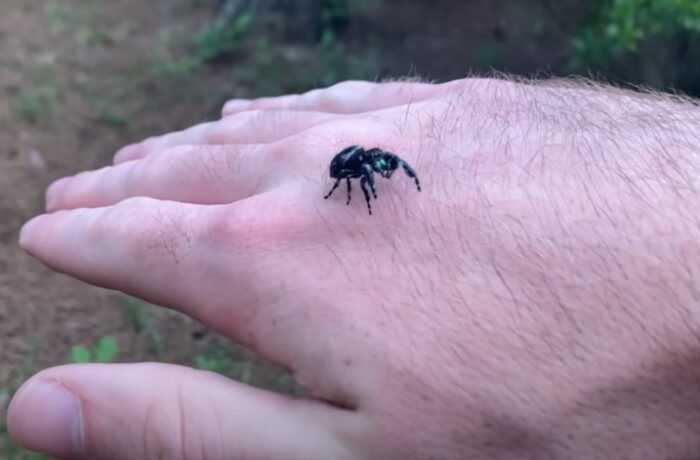
- No Venom: Jumping spiders have no venomous fangs or poison glands that can harm humans. At most, a bite would feel like a tiny pinprick.
- Timid Nature: Bold jumpers are not aggressive toward humans and will only bite as an absolute last resort if threatened. Most bites happen due to mishandling.
- Weak Jaws: While they have an outstanding leaping ability to catch prey, their jaws are not robust enough to break human skin.
In short – they lack the venom potency and physical size to pose any danger to people. With gentle and proper handling, there is virtually no risk.
Housing Your Cute Bold Creature
Caring for a bold spider begins with setting up proper housing for your new pet. Here are some tips:
Enclosure size:
Use small tanks or terrariums of 5-10 gallons. Babies can start in containers as small as large plastic cups.
Substrate:
Use 2-3 inches of substrate like coconut fiber, potting soil, or peat moss to mimic their natural environment.
Decorations:
Add pieces of bark, small plants, sticks, leaves, and stones for climbing, hiding, and enrichment.
Lid:
Secure the lid, as bold jumpers can leap up to 8 inches high. Make sure the top has air holes for ventilation.
Temperature:
Ideal temps are 70-80°F. Avoid extremes of hot or cold.
Humidity:
Maintain a humidity level of 60-75% to help prevent molting issues. Mist the tank daily if needed.
Water dish:
Make sure to give them a small, shallow container of water that is cleaned and replenished consistently.
Hiding places:
Give your bold jumper places to hide, like cork bark, foliage, and artificial caves. Decent hiding places reduce stress.
Proper housing helps create a comfortable environment for your spider and encourages natural behaviors like burrowing and jumping. Monitor your bold spiders regularly to ensure they are very lively!
Handling Your Bold Jumping Spider
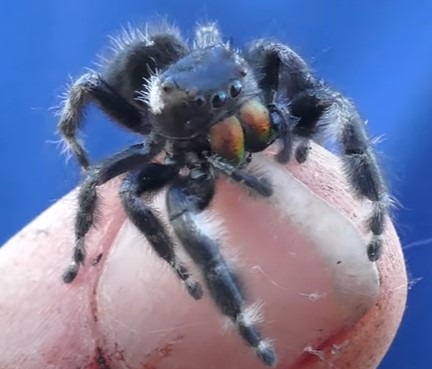
The bold spider’s friendly, inquisitive nature makes it one of the few tarantulas that can be safely handled if done gently. Note some handling tips:
- Start by allowing your spider to walk calmly onto your open hand. Never grab them forcefully.
- Keep your hand low to the ground while handling it in case they leap off.
- Avoid making sudden movements that can startle your spider while holding them.
- Only handle for short 5-10 minute periods to avoid stressing your spider.
- Scrub your hands with soap and water before and after touching to remove any oils or scents.
- Supervise closely when allowing children to handle, as drops can injure a spider.
- Bold spiders may leap suddenly if frightened. Always stay calm and avoid squeezing them if they jump while handling.
- Never handle after a molt when they are vulnerable or when showing signs of aggression like raised front legs.
With the proper calm approach, regular but brief handling lets you bond closely with your cute spider!
Related Articles:
- Regal Jumping Spider: Expert Care, Breeding, and Price Guide
- Knowing Your Jumping Spider Pet: A Comprehensive Guide
Feeding Your Bold Spider
In the wild, the bold jumping spider eats a varied diet of live insects and other invertebrates. In captivity, they should be fed:
- Crickets: The ideal staple feeder insect. Offer appropriately sized crickets 2-3 times per week.
- Mealworms, Waxworms, Roaches: Vary the diet by including these staple feeders.
- Flies, Moths: Offer occasional treats like fruit flies, green bottle flies, and silkworm moths.
- Water: Continuously provide a small container filled with water inside their habitat.
- Supplements: Lightly dust prey with calcium and vitamin D3 supplements 1-2 times monthly.
- Food Size: Feed insects no more significant than 1/2 the size of your spider to prevent choking or injury.
- Feeding Tips: Place live prey directly into your spider’s enclosure. Bold jumpers are skilled hunters and prefer to catch moving targets.
With this varied feeding routine, your Phidippus audax will thrive on a healthy, nutrient-rich diet!
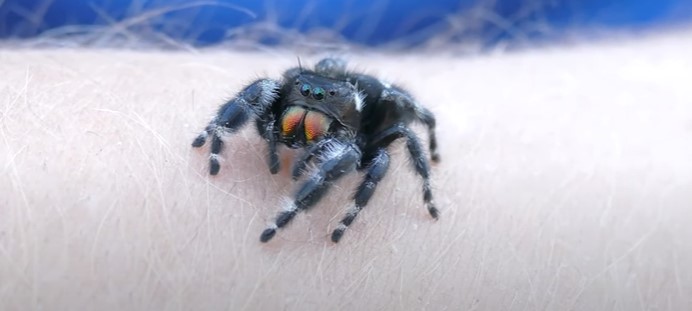
Common Health Issues
When cared for properly, the bold spider generally enjoys excellent health. However, here are some potential health issues to watch for:
- Molting issues: Molting trouble like falling during a shed or stuck exoskeletons. Maintain proper humidity to prevent problems.
- Loss of limbs: In rare cases, a limb may be injured or fall off during a molt. But spiders can regenerate lost limbs at their subsequent shedding.
- Dehydration: Ensure the enclosure isn’t too dry, and the water dish is refreshed routinely.
- Parasites: Bold jumping spider eggs binding: mites or nematodes. Look for symptoms like a swollen abdomen. Seek vet help for parasite removal.
- Phidippus audax eggs binding: Females may have difficulty depositing an egg sac. A vet can assist if needed.
By responding quickly to health concerns and keeping your bold jumper’s environment clean and ideal, you can enjoy your pet’s companionship for years to come!
Fun Facts About the Phidippus audax
Beyond being a fun and straightforward pet, the spider has many fascinating traits and behaviors that make observing them highly enjoyable:
- Jumping spiders have excellent vision and can clearly see objects up to 18 inches away. Some species have a 360-degree vision from their multiple eyes.
- They are covered in sensitive hairs that help detect the slightest air movement around them. This assists with sensing prey or threats.
- Bold jumpers wave and bob their front legs to communicate with each other using motions, scents, and vibrations.
- The male jumping spiders have unique mouthparts named pedipalps. They use these parts to pass sperm to the female when breeding.
- Jumping spiders perform elegant courtship dances and vibrations to attract mates. The male will dance to charm the female Phidippus audax.
- They construct small silken nests or tubes under bark, rocks, or plants to rest during the day and retreat from threats.
- Baby jumping spiders hatch from an egg sac laid by the female and look like tiny versions of the adults.
With so many challenging behaviors and physical adaptations, the bold jumper makes for captivating watching, in addition to being a delightful pet.
Key Takeaways About the Rewarding Pet
Few arachnids can compare to the Phidippus audax when it comes to an engaging pet that is safe for persons of all ages. Following this guide on their ideal habitat setup, handling methods, nutrition, and health care, you can keep your bold jumper healthy and thriving.
Observing their active nature, brilliant vision, and outstanding leaping ability is a fascinating experience. And their large front eyes seem to connect with you, showing awareness and curiosity. For those ready to welcome a rewarding spider into their home, the jumping spider’s miniature size and simple needs make them an excellent choice.
Related Post: Grass Spider: Appearance, Habitat, Lifecycle, Preventive Measures
FAQs:
How do you identify a bold jumping spider?
The bold jumping creature can be identified by its distinct appearance – it has a round, black body with white spots or patches and four pairs of eyes with large front-facing principal eyes. They have a legspan of around 1/2 to 3/4 inch.
How do bold-jumping spiders hunt?
They don’t spin webs to catch prey. Instead, they actively hunt by stalking and ambushing prey. They pounce up to 10 times their own body length to capture prey.
What is the other name for the jumping spider?
The black jumping spider is known by its scientific name, Phidippus audax. They are sometimes called daring jumping spiders or bold jumper spiders as well.
Why are they called jumping spiders?
They get their name from their ability to jump from place to place. They use their strong legs to jump up to 50 times their body length.




Leave a Reply